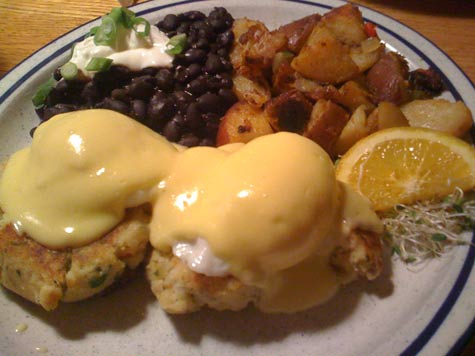
HOMEMADE: And yummier for the proximity to the couch. |
There is no worse fate than the purgatory of Sunday brunch. The scene is almost universally the same: after a night of aggressive drinking and merriment, boozy plans are laid to meet up in the morning for brunch. There are several terrific places where this brunch might go down in Greater Portland, but they are all likely to share one ingredient: a line stretching out the door. Your arrival in last night's party clothes and disheveled hair barely elicits a nod from your equally hung-over companions, already there staking out a place on the waiting list.
The reasons for venturing out to have somebody else serve you in this impaired state are many, but it might have been better for your constitution (and reputation) to stay home in your bathrobe. Executing a presentable Eggs Benedict can made the decision to leave the house for brunch a choice, instead of a forced march.
The constants in this dish are the poached eggs, placed on top of English muffins or toast, and covered in hollandaise, one of the classic French sauces. The traditional preparation includes a slice of Canadian bacon, but there are countless variations that exist, including smoked bacon, sautéed spinach, smoked salmon, crab cakes, and tomato. What you put in yours is for you and your refrigerator to figure out.
To get started, clarify a stick of butter. (This is done by melting the butter completely and then, after it cools, skimming and discarding the foamy stuff off the top.) To help the process along, we can place a bowl of melted butter in the fridge while we work on some of the other pieces.
My childhood friend Margaret demystified and de-messed the process of poaching eggs, and I will be forever thankful. Line a small bowl with a square of plastic wrap, spraying the wrap with cooking spray, or putting in a few drops of olive oil. Crack an egg into the bowl, wrap the egg in the plastic, and tie with some string or cooking twine. Place the egg bundles into a pot of simmering water, and cook for five or six minutes, with the longer cooking time yielding a firmer yolk. Don't boil the water, as it will adversely affect the texture of your eggs.
The classic technique for hollandaise sauce is to place three egg yolks in a heatproof (i.e., metal or Pyrex) bowl with a tablespoon of cold water or white wine, and whisk until fully blended. Bring a small pot of water to a boil, and then turn off the heat and place the bowl over the top of the pot, whisking constantly. As the eggs begin to thicken, remember to scrape down the sides of the bowl. Once the mixture is thick and voluminous, add the cooled butter very slowly, a teaspoon at a time, still whisking constantly. The sauce should become shiny and continue to emulsify. Add a tablespoon of lemon juice, a dash of hot sauce, and salt and pepper to taste. Set aside for a few brief moments while the other pieces come together, but don't wait too long, as the sauce should be used shortly after preparation.